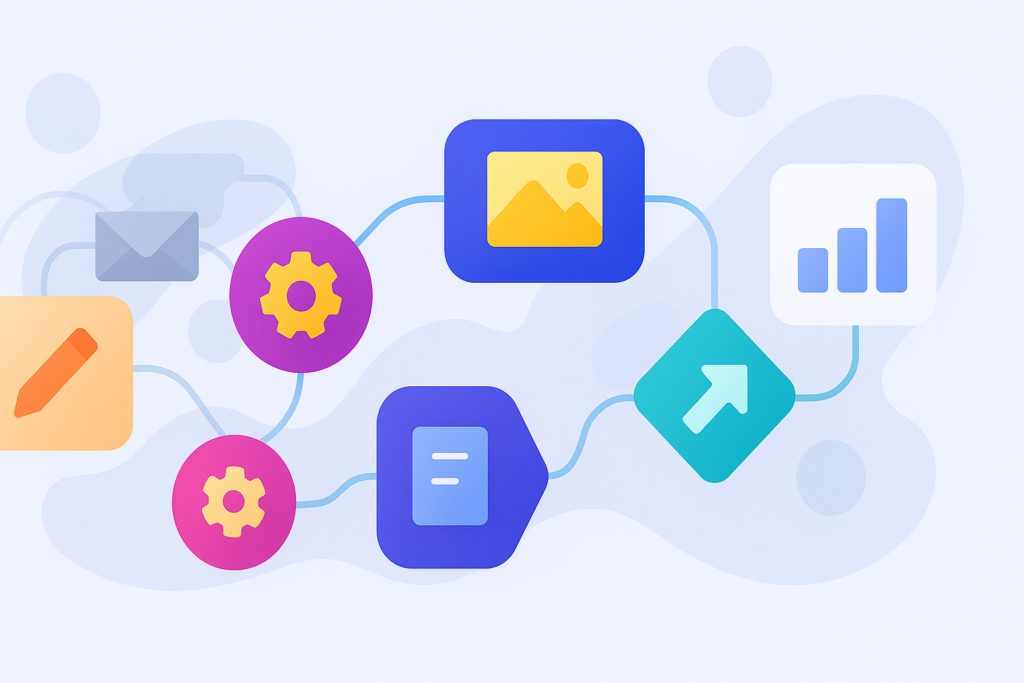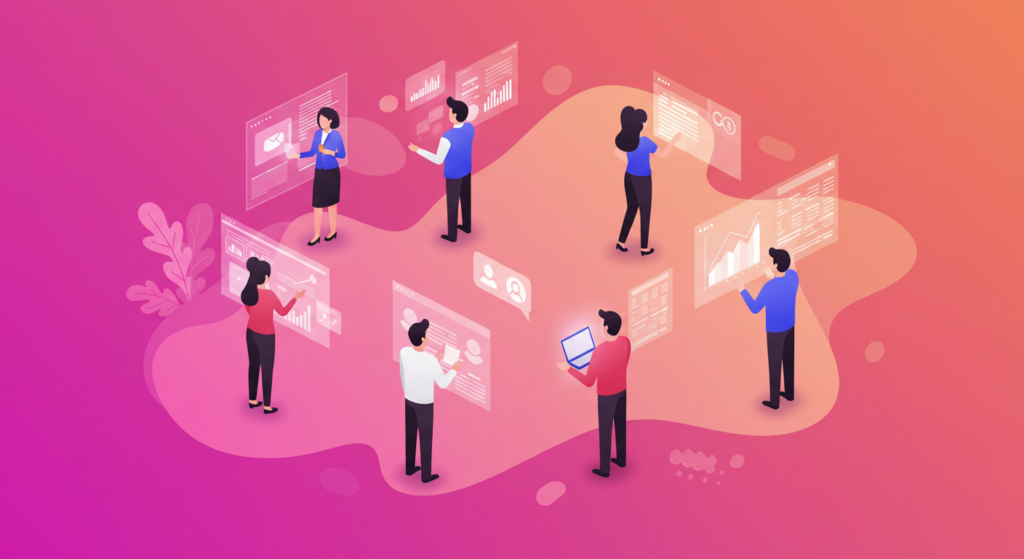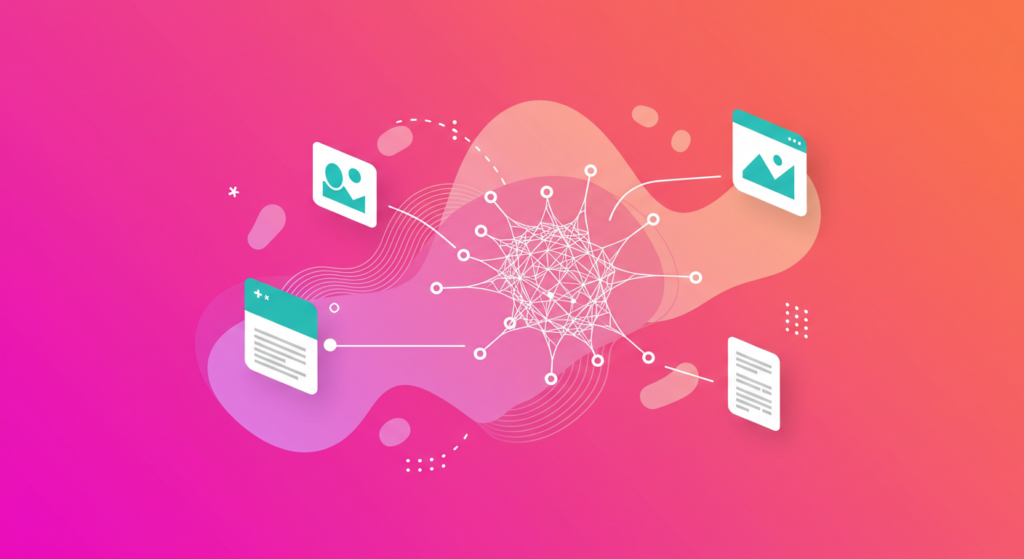Companies leveraging personalization drive 40% more revenue than those that don’t. Yet most B2B organizations are stuck in a personalization paradox: customers demand hyper-relevant experiences while marketing teams drown in the complexity of delivering them at scale.
Traditional AI tools promised to solve this challenge, but they’ve largely fallen short. Generative AI creates content while predictive AI forecasts outcomes, but both require constant human intervention to make decisions and take action. Enter agentic AI, a transformative technology that autonomously optimizes content operations workflows and delivers personalized experiences without the operational bottlenecks that plague most marketing teams.
Unlike its predecessors, agentic AI operates with true autonomy, making real-time decisions about content placement, audience targeting, and campaign optimization. B2B personalization is experiencing a seismic shift from reactive content management to proactive, intelligent orchestration.
What Makes Agentic AI Different from Traditional Marketing AI?
The evolution from basic automation to agentic AI mirrors the progression from calculators to smartphones. Besides being more powerful, it’s fundamentally different in capability and application.
Traditional marketing automation follows predetermined rules: “If lead downloads whitepaper, then send follow-up email.” Generative AI adds content creation: “Write a follow-up email for leads who downloaded this whitepaper.” But agentic AI operates at a higher level of intelligence, understanding context, setting goals, and executing complex multi-step workflows independently.
Autonomous content AI systems can analyze a prospect’s entire digital journey, identify content gaps in real time, and automatically deploy the most relevant assets across multiple channels. In the meantime, it learns and adapts from each interaction.
The distinction becomes clear when examining how each approach handles B2B personalization challenges. Traditional systems require marketers to manually segment audiences and create rules for each scenario. Generative AI helps create variations of content for different segments. Agentic AI autonomously identifies micro-segments, creates tailored content variations, and deploys them across the optimal channels at precisely the right moments.

Consider a complex B2B sales cycle involving multiple stakeholders with different priorities. Autonomous content AI can simultaneously track each stakeholder’s content consumption patterns, identify their specific interests and concerns, and orchestrate a coordinated personalization strategy that addresses the unique needs of the technical buyer, economic buyer, and end-user, all without manual intervention.
The Personalization Scale Challenge in B2B Marketing
B2B marketers face an impossible equation: deliver increasingly personalized experiences to growing audiences while managing ever-expanding content libraries. Research shows that 89% of marketers consider personalization an important metric of success, yet many struggle with the operational complexity required to execute effectively.
The traditional approach to B2B personalization creates exponential complexity. A single campaign targeting three industries, four company sizes, and five buyer personas requires 60 unique content variations. Add multiple channels, and you’re looking at hundreds of assets to create, manage, and optimize. Most marketing teams simply can’t scale this manually.
Agentic AI operates at the intersection of content intelligence and autonomous decision-making. Instead of requiring marketers to anticipate every personalization scenario, these systems continuously analyze audience behavior, content performance, and engagement patterns to make intelligent recommendations and optimizations in real-time.
The technology excels at managing what marketers call “the long tail of personalization,” those highly specific audience segments that are too small to justify manual attention but collectively represent significant revenue opportunities. Autonomous content AI can identify these micro-segments, create targeted experiences, and measure their impact without consuming human resources.
B2B organizations have to deal with complex buying committees where different stakeholders require different content at different stages of their evaluation process. Adaptive content delivery systems can track multiple decision-makers within a single account, understand their individual preferences and priorities, and orchestrate cohesive yet personalized experiences for each stakeholder.
5 Ways Agentic AI Transforms B2B Content Workflows
The practical applications of agentic artificial intelligence in B2B marketing are reshaping fundamental workflows and creating new possibilities for engagement and conversion.

1. Intelligent Content Gap Analysis and Creation
Agentic AI continuously monitors content performance across all touchpoints, identifying gaps between audience needs and available assets. When the system detects that enterprise prospects are consistently dropping off after viewing pricing content, it can automatically commission or generate supplementary materials like ROI calculators or implementation timelines.
This capability transforms reactive content planning into proactive opportunity identification. Instead of waiting for quarterly reviews to reveal content gaps, marketing teams receive real-time insights about missing assets that could improve conversion rates for specific audience segments.
2. Dynamic Asset Optimization and Versioning
Traditional content personalization requires creating multiple versions of each asset for different audiences. Autonomous content AI dynamically optimizes existing content elements based on real-time engagement data.
The system can automatically adjust messaging tone for different industries, swap out case studies based on company size, or modify call-to-action language based on the visitor’s position in the buying journey. Adaptive content delivery ensures that every interaction feels tailored without exponentially increasing content management complexity.
3. Cross-Channel Orchestration and Sequencing
B2B buyers engage across multiple channels, including email, social media, websites, and sales conversations, often simultaneously. Agentic AI can build cohesive experiences across these touchpoints, ensuring that the content a prospect receives via email complements what they see on the website and aligns with sales conversations.
This process extends to timing and sequencing. The system understands that a prospect who downloads a technical specification sheet may be ready for a product demo invitation, while someone who reads thought leadership content might need additional educational materials before sales engagement.
4. Predictive Content Performance and Resource Allocation
Autonomous content AI predicts which types of assets will perform best for emerging audience segments or market conditions. By analyzing historical performance data, engagement patterns, and external market signals, these systems can recommend content investments with a higher probability of success.
This predictive capability helps marketing teams more effectively allocate limited resources, focusing creative efforts on content types and topics most likely to drive meaningful business impact.
5. Automated Compliance and Brand Consistency
For B2B organizations operating across multiple markets or industries, maintaining brand consistency while meeting local compliance requirements is a significant operational challenge. Agentic AI can automatically review content for brand guideline adherence, regulatory compliance, and market-specific requirements before publication.
The system learns from previous approvals and rejections, becoming more sophisticated in its ability to identify potential issues and suggest corrections. This automation reduces review cycles while maintaining the quality and compliance standards essential for B2B marketing.
Real-Time Decision Making and Adaptive Content Delivery
The true power of agentic AI emerges in its ability to make split-second decisions about content delivery based on real-time behavioral signals. Unlike traditional personalization engines that rely on historical data and predetermined rules, these systems analyze current context to deliver truly adaptive experiences.
Adaptive content delivery systems simultaneously monitor hundreds of variables, from the visitor’s current session behavior to external factors like market conditions or competitive landscape changes. This comprehensive analysis enables decisions that consider who the visitor is, what they’re trying to accomplish right now, and how external factors might influence their needs.
For example, when a prospect from a company that just announced layoffs visits your pricing page, agentic AI might automatically surface content about cost optimization and efficiency gains rather than growth-focused messaging. This contextual awareness creates more relevant experiences while demonstrating genuine understanding of the prospect’s current challenges.
The technology also excels at cross-session learning, building comprehensive profiles that capture the complete customer journey across multiple touchpoints and time periods. This persistent intelligence enables increasingly sophisticated personalization as relationships deepen and buying processes progress.
Autonomous content AI systems can also adapt content presentation based on device context, time constraints, and attention patterns. A mobile visitor during commute hours might receive condensed, visual content, while a desktop user during business hours could see detailed technical specifications and comparison charts.

Integration with Existing Content Operations Infrastructure
One of the biggest barriers to agentic AI adoption is the perception that it requires completely rebuilding existing content management infrastructure. In reality, the most successful implementations integrate seamlessly with established content operations platforms and digital asset management systems.
Modern agentic AI solutions are designed to enhance rather than replace existing workflows. They can connect with content management systems, customer data platforms, marketing automation tools, and analytics platforms through APIs and integrations, creating a unified intelligent layer that amplifies the value of existing investments.
Integration typically starts with content discovery and optimization within current systems. Autonomous content AI can analyze existing asset libraries, identify high-performing content patterns, and recommend optimization strategies without requiring migration to new platforms.
As organizations become more comfortable with the technology, they can gradually expand agentic AI capabilities to include automated content creation, cross-channel orchestration, and predictive analytics. This phased approach reduces implementation risk while demonstrating value early in the adoption process.
AI-driven content personalization becomes more powerful when it can access comprehensive content metadata, usage analytics, and performance data from existing systems. The combination of agentic artificial intelligence with rich content operations data creates opportunities for optimization that neither could achieve independently.
Measuring Success and ROI of Agentic AI Implementation
Successful implementation requires sophisticated measurement approaches that capture both efficiency gains and revenue impact. Traditional content marketing metrics like page views and download counts provide insufficient insight into the autonomous decision-making value these systems create.
Key performance indicators for agentic AI initiatives typically focus on three categories: operational efficiency, engagement quality, and revenue acceleration. Operational metrics include reduced content production time, decreased manual optimization tasks, and improved asset utilization rates across content libraries.
Engagement quality metrics examine whether autonomous content AI decisions actually improve user experience and conversion rates. Consider metrics like time spent with content, progression through content journeys, and conversion rate improvements for personalized versus non-personalized experiences.
Revenue acceleration metrics tie agentic AI capabilities directly to business outcomes: shortened sales cycles, increased deal sizes, and improved win rates for opportunities that experienced personalized content journeys compared to standard engagement paths.
Organizations implementing adaptive content delivery systems often see compound benefits that extend beyond immediate metrics. Improved content relevance leads to higher engagement, which provides richer behavioral data, which enables more sophisticated personalization, creating a virtuous cycle of continuous improvement.
Advanced measurement approaches also consider the predictive accuracy of agentic AI systems over time. As these systems learn from more interactions and outcomes, their ability to predict content performance and optimize resource allocation should demonstrably improve, creating long-term competitive advantages.
Implementation Roadmap: Getting Started with Agentic AI
Most organizations approach implementation through a structured roadmap that balances immediate value delivery with long-term capability building. Successful deployments start with clearly defined use cases that demonstrate measurable business impact before expanding to more complex applications.
The foundation phase typically focuses on data preparation and integration readiness. Agentic AI systems require access to comprehensive content metadata, user behavior data, and performance analytics to make intelligent decisions. Organizations must ensure their content operations infrastructure can provide this data in formats that enable effective AI analysis.
Pilot programs often begin with content optimization within existing workflows. Dynamic content personalization initiatives can demonstrate value without requiring complete workflow transformation, building organizational confidence while generating early wins.
The expansion phase introduces more autonomous capabilities like automated content creation, cross-channel orchestration, and predictive analytics. This phase requires a stronger change management focus as teams adapt to new workflows and decision-making processes enabled by autonomous content AI.
Maturity phase implementations leverage agentic AI for strategic initiatives like market expansion, competitive response, and innovation acceleration. At this stage, the technology becomes integral to content strategy and business planning rather than just tactical execution.
Throughout implementation, successful organizations maintain focus on specific business outcomes rather than technology adoption for its own sake. Agentic artificial intelligence should solve clearly articulated business problems and deliver measurable improvements in efficiency, engagement, or revenue.
The Future of Autonomous Marketing Intelligence
The trajectory of agentic AI development points toward increasingly sophisticated capabilities that will reshape how B2B organizations approach marketing and customer engagement. Current systems represent early implementations of technology that will become exponentially more powerful as data sources expand and algorithms evolve.
Future autonomous content AI systems will likely integrate real-time market intelligence, competitive analysis, and predictive modeling to make strategic recommendations beyond content optimization. These systems might suggest new market opportunities, predict competitive responses, or recommend partnership strategies based on comprehensive market analysis.
Integrating with other emerging technologies like augmented reality, voice interfaces, and Internet of Things devices will create new opportunities for personalized B2B engagement. Content experiences will extend beyond traditional digital channels to include physical environments, voice interactions, and contextual computing scenarios.
Adaptive content delivery will evolve to consider increasingly sophisticated contextual factors, including emotional state analysis, attention modeling, and environmental conditions. Future systems might adjust content complexity based on the reader’s cognitive load or modify presentation format based on ambient lighting conditions and device orientation.
The integration of agentic AI with advanced analytics and simulation capabilities will enable organizations to test content strategies in virtual environments before implementation, reducing risk and accelerating optimization cycles.
Embrace the Agentic Advantage
For B2B organizations struggling with the complexity of modern personalization demands, agentic artificial intelligence offers a path forward that actually simplifies operations while improving outcomes.
The competitive advantage belongs to organizations that recognize agentic AI as infrastructure rather than experimentation. Like previous waves of marketing technology adoption, early implementers will establish capabilities and learning curves that become increasingly difficult for competitors to match. Success requires thoughtful implementation that balances technological capability with business strategy, but the organizations making this investment now are positioning themselves for sustained competitive advantage in an increasingly complex marketing landscape.
Aprimo’s AI-powered Content Intelligence and SMART Digital Asset Management platform already delivers many of the autonomous capabilities discussed here. With built-in AI features that require no additional licensing costs and seamless integration with existing tech stacks, we’re uniquely positioned to evolve alongside agentic AI developments. Discover how leading organizations are leveraging Aprimo’s intelligent content operations to deliver exceptional customer experiences at scale.
Frequently Asked Questions
What’s the difference between agentic AI and generative AI for marketing? Generative AI creates content based on prompts, while agentic AI makes autonomous decisions about content strategy, optimization, and deployment. Agentic AI can use generative capabilities but adds independent decision-making and continuous optimization without human intervention.
How does agentic AI improve B2B personalization compared to traditional automation? Traditional automation follows predetermined rules for content delivery. Agentic AI analyzes real-time behavioral data, market conditions, and content performance to make intelligent decisions about personalization that adapt continuously based on new information and changing circumstances.
What data infrastructure is required for agentic AI implementation? Effective agentic AI requires access to comprehensive content metadata, user behavior analytics, engagement tracking, and performance data. Most organizations can start with existing content management and analytics systems, then gradually expand data integration as capabilities mature.Can agentic AI integrate with existing content management systems? Yes, modern agentic AI solutions are designed to enhance existing infrastructure through APIs and integrations rather than requiring complete system replacement. Organizations can add intelligent capabilities while preserving current investments and workflows.


